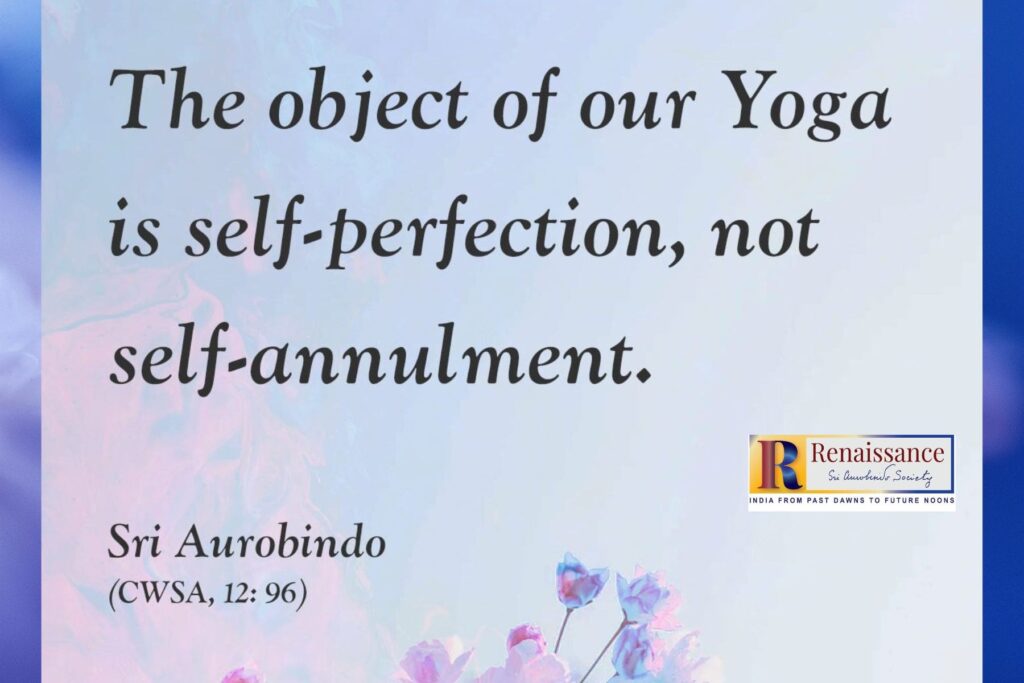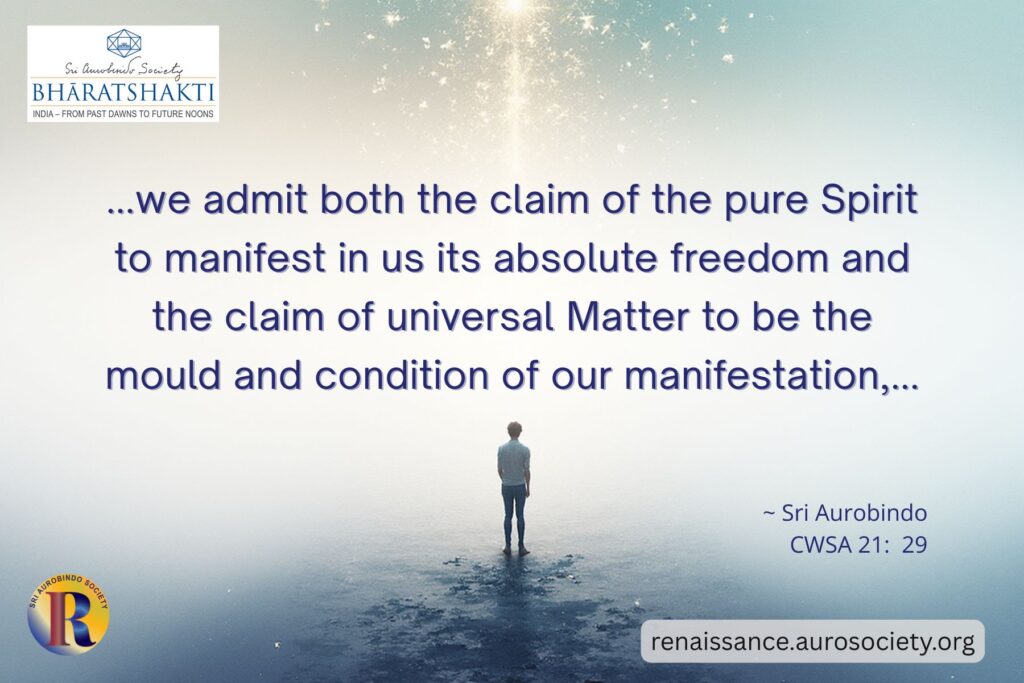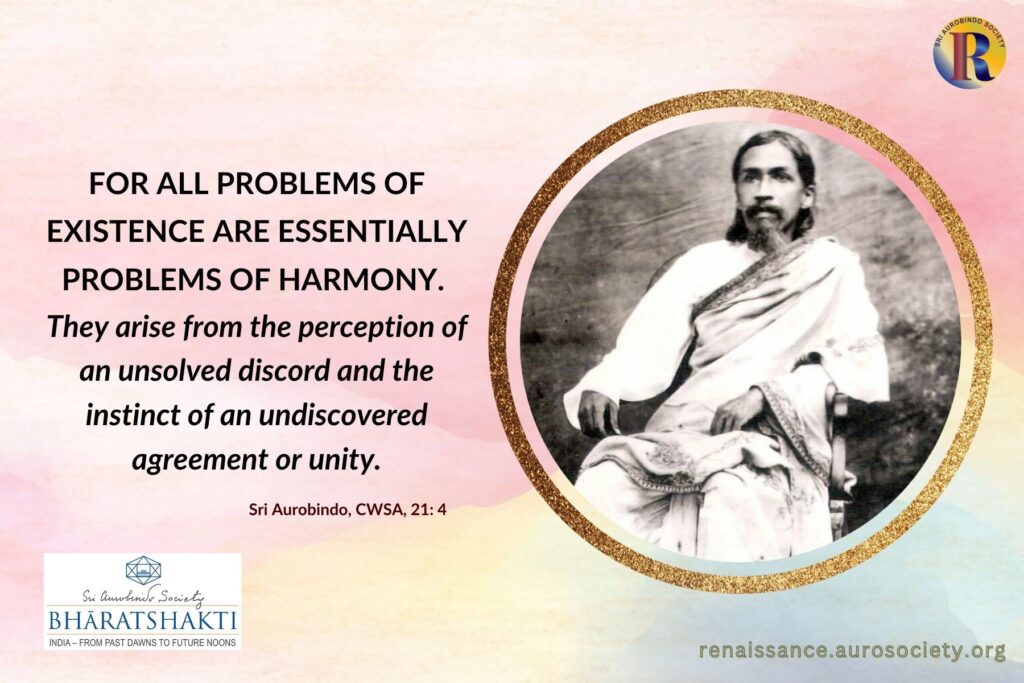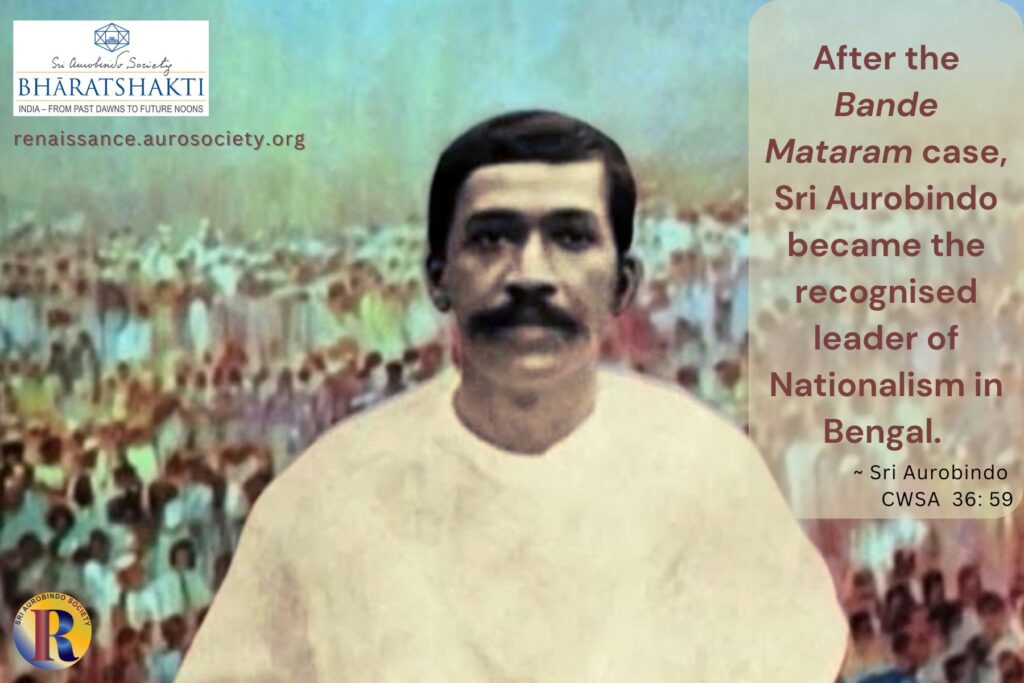Volume II, Issue 1
Author: K.D. Sethna (Amal Kiran)
Editor’s note: Speaking of Sri Aurobindo as the greatest yogi of our age, Amal Kiran tells us that Integral Yoga, set on a manifold practical basis by Sri Aurobindo, promises the emergence of a new state of consciousness by which our persisting problems, individual and collective, will be radically solved.
The following excerpts are taken from “The Sun and the Rainbow: Approaches to Life Through Sri Aurobindo’s Light.” Published by Clear Ray Trust, 1981 (2nd edition, 2008), pp. 3-7, pp. 26-28. Most of the writings collected in this book come from the pages of the Mother India, the monthly review of culture, published from the Sri Aurobindo Ashram, which was edited by Amal Kiran for more than 50 years.
A wishy-washy play with the Unknown is not Indian mysticism. India has established a sustained systematic process leading to it from many starting-points, and that is what is meant by Yoga. Yoga is “yoking”, a union of the human with the Divine: its results are concrete and verifiable. Long and arduous is the path, but there can be no mistake about its practicality: thousands in India even today take it up and pursue it to one end or another.
Various ends have been put before the Yogi, all realisable by a steady endeavour, but they fall mainly into two classes of realisation: the static and the dynamic.
The masters of the static path regard the world as a thing to be thrown aside, a temporary bagatelle. They aim at an absorption in the vast Divine. Their experience of a mysterious Eternal, compared to which the world is like an empty hallucination, is overwhelmingly concrete, but it diverts the consciousness from the earth’s normal activities and gives no final raison d’etre to them.
Why did the Eternal bring about or permit the pageant of Time and Space if its aim was merely to renounce it? Such a renunciation is indeed not unpractical escapism towards a sort of day-dream; it is escapism without being unpractical, for what its escape leads to is felt as a greater reality behind Nature rather than as an imaginary or theoretical “thin air”.
All the same, there is a certain one-sidedness which is not in tune with the modem trend of life no less than with the secret instinct of mankind that the earth too has importance and is no flimsy foil to heaven. India today is awake to that deep instinct and its penchant is for synthesis, for many-sided unity. And the Dynamic Yoga which-is the other side of spiritual realisation in India’s past falls in with such a penchant.
The dynamic Yoga regards the world as a field of God’s manifestation, not as a trap from which the soul must break out. The finest expression of it in our history is the “Song Celestial”, the Bhagavad Gita.
The Gita is not an ascetic cry; it does not seek to pluck one away from the throbbing heart of things. It is a gospel delivered on a battlefield with warriors brandishing their spears and holding drawn bows of destruction.
In fact, the scene is remarkably like the modern world with the holocaust of a terrible conflict not long past and the heart-numbing threat of the Cold War all about us. And the word of Sri Krishna is not a pious advice to stand aside from the grim actuality but “Go forth and fight: conquer a mighty kingdom” because on the one side stood in burning indignation the defenders of civilised values and on the other a titanic tyranny.
Sri Krishna, however, did not look forward to just an outward triumph. The warrior was asked to rise above the ordinary human consciousness and live in the light of the Eternal and be by Yoga the instrument of a Will wider than his own.

The Greatest Yogi of Our Age
An attitude similar to the Gita’s is to be found in the greatest Yogi of our age, Sri Aurobindo. That is why in these times of tense body and alert mind, with upheavals in our midst and upheavals around us, he stands as a modem among the modems.
The eyes of renascent India turn to Pondicherry, the little town on our east coast, capital of the one-time French India, where a school of spirituality, an Ashram with hundreds of disciples, sprang up with him as its centre.
A magnificent leonine personality – a writer educated from boyhood in England and using the English language like a mother-tongue in splendid poetry as well as prose, a scholar in Greek and Latin, at home in French, German and Italian, not to mention Sanskrit and other Indian languages, once a politician of profound constructive power, a gigantic philosophical intellect whose chief work, The Life Divine, has been hailed as epoch-making, a still more towering Master of Yoga, whom Tagore in the East and Rolland in the West called the custodian of the future – Sri Aurobindo was a figure to dominate the world’s gaze.
For six years he led his country’s fight for political freedom. Then suddenly he left politics to concentrate more completely on the Yoga he had already been practising for some years. He felt his withdrawal into the background a most necessary step, because the true genius of India was itself a background – the deep Spirit waiting secretly behind the clamour and conflict raging in the outer being of man.
India’s greatness in the past arose, according to Sri Aurobindo, from her possession of the hidden Spirit by Yogic experience.
The Spiritual Background, however, was not his whole objective. In India’s finest hours the contact with the outer being was never lost. Sri Aurobindo sought for something more than a contact which, after a brief flash of illumination, lets the outer being remain the half-lit and stumbling creature it normally is. As in the background, so too in the forefront there must always be the Spirit.
His Yoga is integral, an all-round fulfilment of the Divine on this very earth and not in a remote paradise or a transcendental Nirvana. That is why Pondicherry, with its Ashram, can be regarded as the gateway to a wonderful future.
Divinisation of Life
Sri Aurobindo holds that man’s hopes and dreams can be crowned only if, with the help of the highest consciousness developed up to now, we rise beyond ourselves to a new level of being, a level above mind as mind is above animal life and animal life above mere matter in which everything lay latent and unevolved.
This new level has to be a step forward in evolution and not just Science, Philosophy Art, Ethics or Religion achieving combinations and permutations of the various aspects of man at his cleverest and noblest.
Sri Aurobindo takes up the whole beautiful heritage of past progress but does not rest with giving it a novel shape: he seeks to divinise the entire self by a special experience and ultimately permeate with a spiritual power of consciousness every means of manifestation and the entire outer form so that even the poor body which lives a victim to disease and decay and the sudden stroke of death may become king of Nature.
[…]
Patiently and without lust for fame the Master kept moulding his vision of super-mankind. The method of his Integral Yoga is a very plastic one. There are no mechanical breath-exercises or painful physical postures; it is our consciousness that the Yoga starts with, a constant remembrance of the Divine and an offering of all our movements, inward and outward, to Him by a consecrated attitude, a self-surrender that brings about a series of extraordinary yet concrete and convincing experiences affecting every side of us, down to our physical substance.
Sri Aurobindo and the Reshaping of Man

We are all familiar today with terms like “subliminal self” and “unconscious mind.” Psycho-analysis has had to posit a complex working of mental process behind and beyond our known thoughts, feelings, desires and volitions. This process is usually called “subconscious” or “unconscious,” but what is meant is that our surface being is not conscious of it.
Nor is the hidden region of the mind merely individual: Jung has noted a common pool of memories and symbols, a depth of racial responses, motives and mythological attitudes preserved through the ages. And he has invented for it the expression: “Collective Unconscious.”
An immense range of psychological being, unhindered by space or time and full of strange possibilities, brilliant or mysterious creativities, surprising supra-personal effectivities, is supposed to exist. And Jung has attempted to show some affinity between his hypotheses and the assumptions of Indian Yoga.
He is right, broadly speaking. For, Yoga is the systematised endeavour to establish contact with unknown profundities of our self by special methods. But it is not limited to what Freud and Jung and their colleagues have got hold of for their field of study. The field of Yoga is much wider, yet it is continuous with the “subliminal” of the psychologists and with their “Collective Unconscious”.
Modern research has, in a very practical manner, provided a jumping-board to the greater claims of this very ancient research.
Yoga chooses as a starting-point the part of one’s being which is most natural to one from day to day according to one’s individual constitution. Thus there are different Yogas for those who are intellectual or emotional or bent upon action – for those who have an introspective turn or such as are physically oriented. This division, pragmatically convenient and effective, has, however, its limitations.
So long as the predominant aim is to pass from the ordinary consciousness to a vaster Beyond and stay more and more absorbed there, believing that life’s destiny is not on the earth but in that mysterious immensity, it does not matter how or where one starts.
The moment life here is emphasised, the moment the stress on earth which modem science has given is accepted and the ideal is not only of individual development and salvation but also of collective and social fulfilment, the need arises of taking up the entirety of our being and making our Yoga integral. To cope adequately with this need is the way of Sri Aurobindo.
According to him, all the parts of our being have to combine under the awakened leadership of that in us which he considers the true soul.
Our true soul is not guided by pet ideas, selfish demands, pragmatic facilities. It is the pure push in us towards what we sense as the supreme Good, what we may regard as the divinely human. Unified by this push, all our parts have to make accessible and normal the powers which are now remote and supernormal and known only in brief occurrences labelled as “inspiration” and “intuition.”
The Integral Yoga, elaborated by Sri Aurobindo and set on a manifold practical basis, promises the emergence of a new state of consciousness by which every one of our persisting problems, individual and collective, will be radically solved.
The reasonableness of such a promise must strike us as soon as we look at the panorama modern biology opens up with its theory of evolution. From insensitive matter we see the emergence of active vitality. From vitality, with its instincts and desires, we see the thinking mind of man emerge, haunted vaguely by the presence of the entity he feels as his “soul.”
Breaking through the routine of human rationality – helped by the aspiration of that vague presence – there is the sporadic play of inspiration and intuition. A more recurrent play of them is seen in the phenomenon of “genius.” Variously we are led to mark the evidence of a supramental faculty waiting to emerge and take up the whole of our existence for a new evolutionary embodiment.
“Embodiment” is an important term. For, Sri Aurobindo is all for a more dynamic earth-life in the light of a more-than-human consciousness. As the Mother puts it: “Yoga is not a contempt for matter but a means to divinise it – not a rejection of the body but a means to transform it.”
Also read:
Integral Yoga – Finding the Divine in Life
~ Design by Rishabh Sharma & Beloo Mehra



